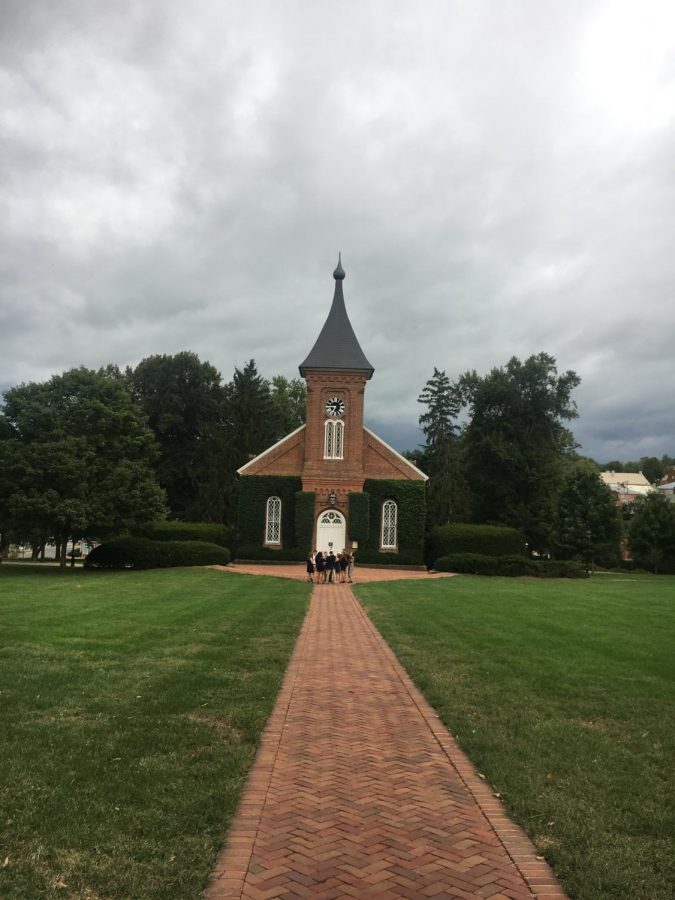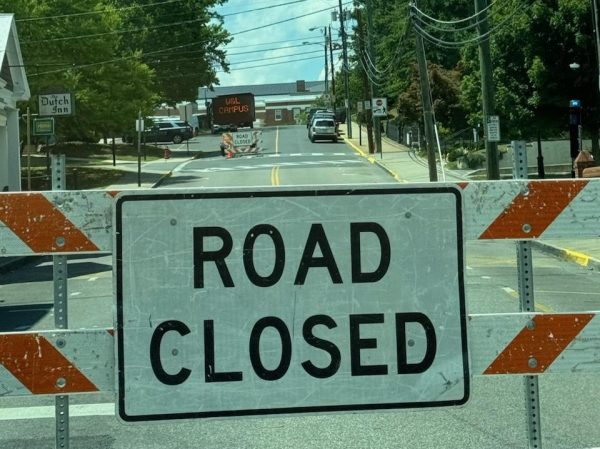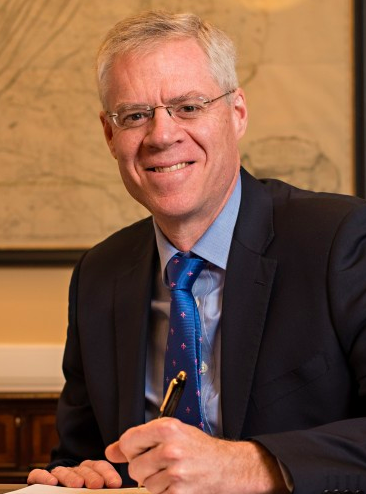W&L will not drop Lee from university name, but Lee Chapel will be renamed
Lee Chapel, a central landmark on campus, will be renamed University Chapel. Photo by Grace Mamon, ’22.
June 4, 2021
Robert E. Lee will remain a part of Washington and Lee University’s name, according to a June 4 email from the board of trustees. But the university will undergo a number of other changes, including a new name for Lee Chapel.
The board formed a special committee in July 2020 to reconsider the university’s relationship with the Confederate general. This was the biggest commitment to changing the name that the board had ever made.
But in the end, the board decided in a 22-6 decision that the school’s name was integral to the success of the university.
“The name we have had for 151 years, and upon which our reputation is built, provides strength and resources critical to advancing our mission and ensuring that we can do good work long into the future,” the board’s email said. “Therefore, we will continue as Washington and Lee University, building on our success and focusing on the actions that have the greatest potential to help all students, faculty, and staff feel welcome, included, and able to thrive.”
The email said there was no evidence that changing the name would position the university to be as successful as possible in the future.
Lee Chapel, however, under which Robert E. Lee and his family are buried, will be renamed University Chapel. This new name is consistent with the building’s original nineteenth-century name, “College Chapel.”
“The board will oversee and approve interior changes to restore [the chapel’s] unadorned design and physically separate the auditorium from the Lee family crypt and Lee memorial sculpture,” the email said.
Kamron Spivey, ’24, who was involved in the “Retain the Name” movement toward the end of the year, said the decision to rename Lee Chapel was a surprise and a disappointment.
“I’m of course, glad that the name of the university is staying the same, that was our big push,” Spivey said. “But I would’ve preferred if they had reassessed the role of Lee Chapel in university events instead of trying to rename it, because really all they’ve done now is denigrate the historical prowess and preservation of the site.”
Spivey said he can understand the decision not to celebrate Founder’s Day and to remove images of the school’s namesakes on diplomas – two other changes the board announced – but he couldn’t understand the decision to rename the chapel.
“I don’t really understand why they decided to remove the name Lee from the chapel because it is physically impossible to separate Lee from that building,” he said. “He’s buried there and unless they strip it down and remove the mausoleum, it will always be about Lee.”
In addition to renaming Lee Chapel, the university will also raise $225 million for scholarships, curriculum and student support. Some of this money will support a new academic center “for the study of Southern race relations, culture, and politics.”
The board also promised to work on its own diversity, equity and inclusion. This will include an effort to increase representation of women and people of color on the board.
And this will include the creation of a new committee on diversity, equity and inclusion and an examination of campus residential and social institutions to “increase accessibility, inclusivity, and choice for all students.”
The email explained how and why the university got its name, saying that both Washington and Lee made direct actions that benefited the school.
In 1796, George Washington made a gift to Liberty Hall Academy that guaranteed its survival. And in 1870, right after Lee died in office as president of the university, the board added his name to recognize his leadership in “saving and transforming the school after the devastation of the Civil War.”
The email acknowledged that the university’s association with these men may be painful for some people, while for others, it is a recognition of the contributions of Washington and Lee.
“Although our name recognizes the connections of our namesakes to the institution, it also has broader significance, representing common experiences and values that are independent of the personal histories of the two men,” the board said. “The university today is not a memorial to our namesakes, but a place that provides an exceptional liberal arts and legal education and fosters relationships that bind generations of students, faculty, staff, and alumni to each other.”
But Spivey said he thinks the board was not sincerely motivated by preserving history. He said there was a lot of financial incentive to keep the name, because wealthy alumni and donors were largely against dropping Lee’s name.
“I would love to say that I think that the board made the decision because they value the tradition and the responsibility that they owe to the preservation of historical events,” Spivey said. “But given that they renamed Lee Chapel…I think the decision was really just on terms of financial cost.”
This decision comes after almost a year of deliberation and on-campus tension, as many university constituents differ in opinion.
Students especially, have been drastically divided about the name change. Some students attended a Change the Name walkout protest in March, while others have been sporting the new “Retain the Name” merchandise.

A majority of the faculty expressed their belief that Lee should be dropped from the university name during a virtual meeting in July, where they voted 188-51 to change the name.
Many older alumni and some parents, on the other hand, will be pleased to hear that the name is not changing.
An open letter to the board, signed by over 200 “concerned parents of Washington and Lee” was published by the Spectator, a student-run conservative publication on campus.
“The school became Washington and Lee University to recognize Lee’s contributions to the school while he was President of Washington College. There is so much history on the campus, and while we don’t have to agree with it all, we should appreciate our past, protect it and seek to learn from it,” the letter says.
Dennis Hull, ’22, editor-in-chief of the Spectator, said he respects the board’s thorough process and thinks they made the right decision.
“Their decision was appropriate, as it clearly reflects both a nuanced understanding of Lee’s contributions to our university and a proper recognition of the important work to be done surrounding diversity,” Hull said.
Though the university will retain its name, the board expressed a continued commitment to a future of diversity and inclusion at Washington and Lee.
“We do this not in spite of the complexity of our history and our namesakes but precisely because of that complexity,” the email said. “We will continue to conduct rigorous and nuanced explorations of our history, with the humility and honesty to acknowledge both our successes and those moments when the university failed to live up to its ideals.”
The modern campus museum, which is part of the university’s strategic plan, will preserve and present the school’s history comprehensively and accurately, once completed, according to the email.
“The events of the last year have divided our community,” the email said. “These divides will take time to heal, and we ask everyone to respect the opinions and perspectives of others. We are confident that W&L will emerge stronger as a result of our active engagement on these issues, the work we have done together, and the actions and commitments we are taking.”
University President William Dudley sent an email to the student body, about an hour after the board’s email.
“The name ‘Washington and Lee’ does not define us. We define it,” he wrote. “While the name has been unchanged for more than 150 years, the institution has been utterly transformed over that span by integration, coeducation, and sustained innovation.”














Richard Margolies • Oct 14, 2022 at 5:17 pm
The Lee name can be retained, but the historical person can and should be changed.
Instead of Lee standing for Col. Robert E. Lee (he never reached General in our Army, the US Army) the Lee name should stand for his father, Henry ‘Light Horse Harry’ Lee. Robert was a traitor to our country. His father was a patriot, General, and friend of George Washington. The son fought against our country, trying to preserve White supremacy and the enslavement of our African American brothers and sisters. The father fought for the independence of our country from British tyranny. The father fought to create our country, the son fought to tear it apart.
The son, Robert, was an educational innovator. He raised funds and kept the financially faltering Washington College alive. He should be honored for these institutional contributions by retaining his statue on the front lawn, by plaques on campus, and in the university history, noting at the same time his patriotic and moral flaws. His qualities of character can be honored also. However, his failures as a US patriot, as a moral person, and as a Christian humanist should not continue to be overlooked and minimized. We should all be honest about our failures and flaws as human beings.
Our famed center of education, our W&L, can achieve greater renown when it decides to no longer honor a man who never renounced his betrayal of our country and remained devoted to human enslavement. Our university will gain more honor in honoring his Robert’s father, a true US patriot, hero, and US General, who fought as a colleague of our other General, George Washington.
Another part of our university stepping up in honor by having Lee be Henry ‘Light Horse Harry’ Lee would be arranging with Stratford Hall, the birthplace of Robert, to receive his interred remains. A solemn black cortege with police escorts could move the remains in fitting ceremony. This would be news-worthy and bring national and international attention to our university’s stepping up morally, and stepping forward into the 21st century.
Richard Margolies, Ph.D.
Class of 1966
Red • Mar 6, 2022 at 1:19 pm
Such a sad and disturbing thing to rewrite historical aspects just bc people dont like how they really happebed or who was involved. Its a discrace to the name of great men that did great things.
MP • Jan 19, 2022 at 3:32 pm
Happy Birthday, Robert.
Kelly O'Keefe • Jun 5, 2021 at 12:20 pm
Not a single quote from those opposed to the name change, despite the majority opposition from the faculty? This isn’t journalism, this is advertising.